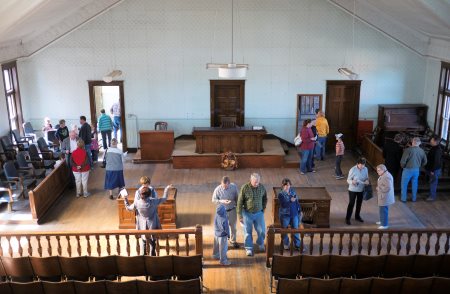Districts prepare for resumption of jury trials Friday, June 19, 2020
With county courthouses gradually reopening to the public, the court system is looking forward to the resumption of jury trials. There are currently more than 3,000 jury trials scheduled to be held before July 1, 2021.
Under Administrative Order 25, the coronavirus pandemic emergency order, all jury trials are suspended until July 1. Unit court administrators are working with judges and county clerks of court to determine how to commence jury trials safely after that date.

Grand Forks County jury assembly area
In Grand Forks County, court staff has put together a jury assembly area that reflects social distancing guidelines. A final walk through is planned for Friday, June 26, with judges and add staff in attendance to test the route jurors will take from the courthouse door to the courtroom itself for trial.

Main courtroom at Stutsman County's historic 1883 courthouse
In Stutsman County, court staff has made arrangements to use the large historic courtroom at the old Stutsman County courthouse for jury trials.
Some of the measures that court staff across the state will be taking to protect jurors and others in the courtroom include:
- Mapping out jury assembly areas and courtrooms to meet CDC/ND Department of Health distance guidelines are met while still ensuring that juror sightlines are not blocked;
- Working on signage for distancing and traffic flow in public areas;
- Ensuring we have masks, gloves, and hand sanitizer available for people when coming to the courthouse;
- Judge instructions on the wearing of masks and distancing in courtrooms/public spaces.
- Working with county staff and our own staff on adding additional cleaning standards during jury trial operations;
- Working on finding additional bailiffs and training them before trial to ensure safety and effective flow of traffic/court operations;
- Using technology to support social distancing standards during the trial so evidence doesn’t need to be passed between jurors;
- Setting up a lectern with shielding and a microphone that would not need to be adjusted during voir dire. The individual jurors could walk up to the microphone (if needed) and speak. Sending out a screening questionnaire in advance of the trial and utilizing the same question format the day of juror arrival;
- Staggering juror report times and calling in smaller groups;
- Considering alternative locations for large trials.
The Supreme Court’s emergency orders relating to the coronavirus pandemic, along with supplementary administrative orders from individual districts, can be found at: https://www.ndcourts.gov/emergency-order-and-pandemic-response

